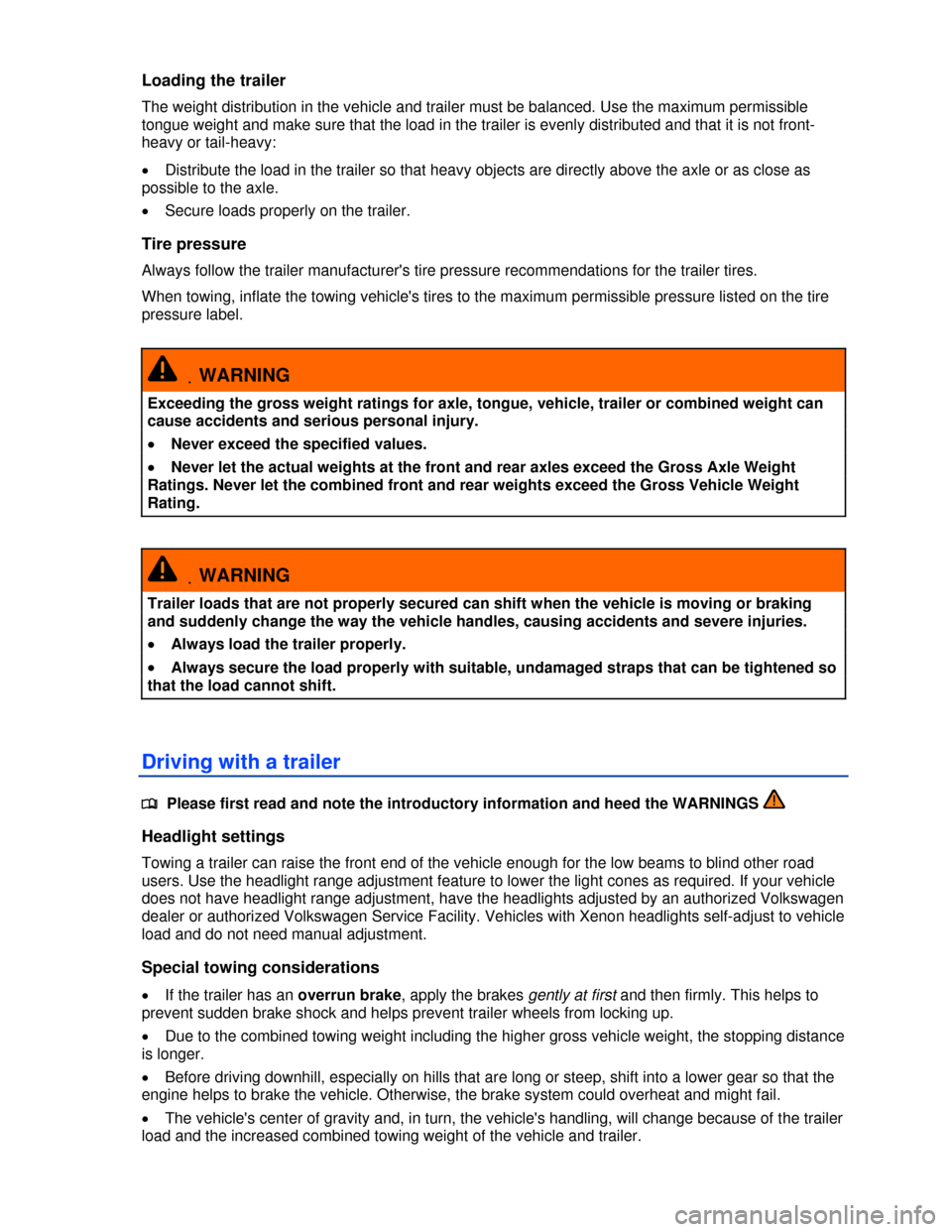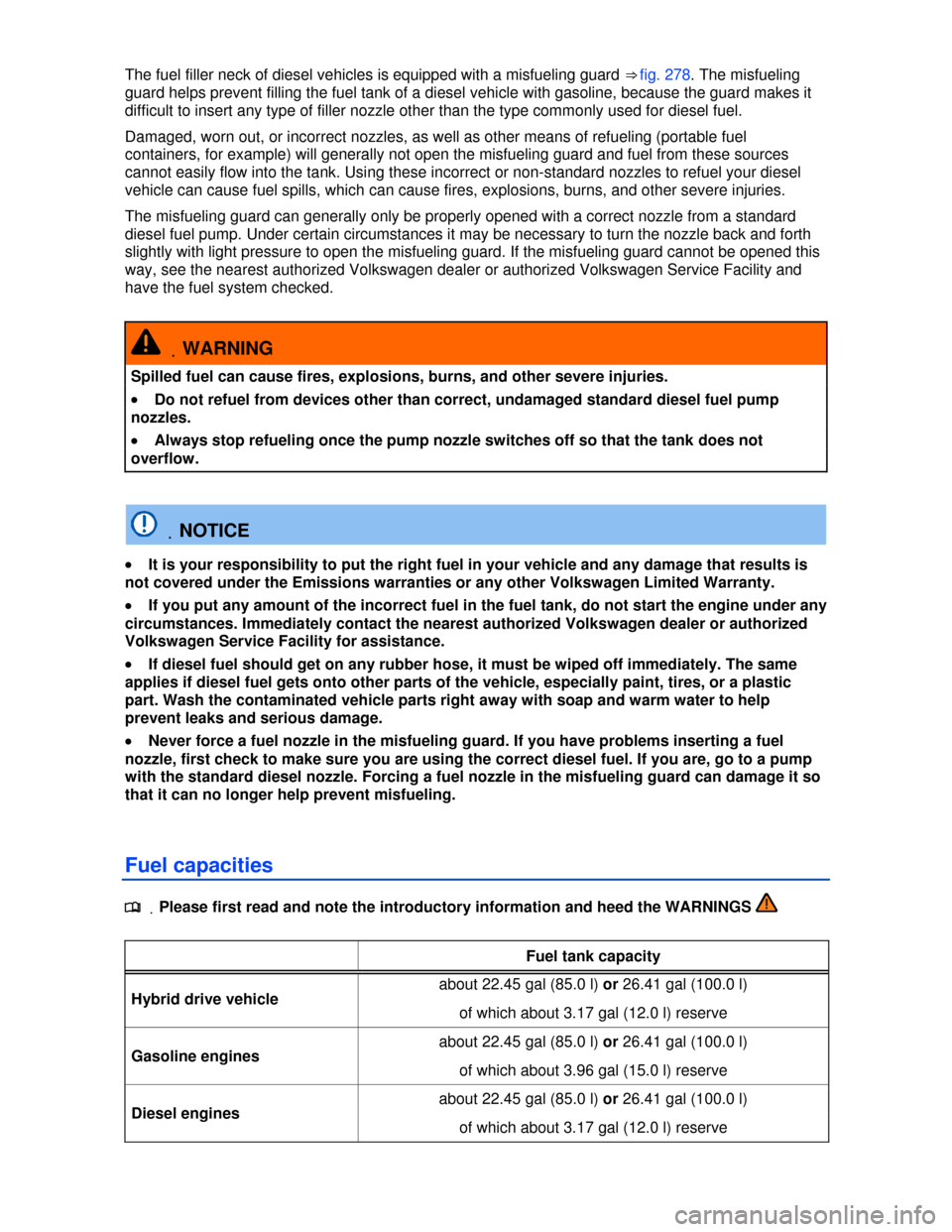2013 VOLKSWAGEN TOUAREG tire pressure
[x] Cancel search: tire pressurePage 21 of 440

Menu Function
Tire pressure Display of current tire pressures in vehicles with direct Tire Pressure Moni-
toring System.
Display since
start
Display and storage of the driving and fuel consumption data compiled from
the time the ignition is switched on to the time it is switched off.
If the journey is continued within two hours after the ignition is switched off,
the information from the new leg of the journey is counted as well. The
memory is automatically cleared if the vehicle is not driven for more than
two hours.
Display since
refuel
Display and storage of driving and fuel consumption data. The memory is
automatically cleared when the vehicle is fueled again.
Display long-
term
Display and storage of the accumulated driving and fuel consumption data
of any number of single trips up to a total driving time of either 19 hours and
59 minutes or 99 hours and 59 minutes, and up to a total distance of either
1,999.9 miles (1,999.9 km) or 9,999 miles (9,999 km), depending on the
instrument cluster version. If one of the stored values is exceeded, then the
memory is automatically cleared and starts again from 0.
Digital speed Switch the digital speed on or off.
Shows the current vehicle speed in digital form.
Alt. speed
display
Switch the second speed on or off.
Shows the current vehicle speed in digital form.
Back The display switches back to the main menu.
Possible displays
Submenu Function
Travel time Driving time in hours (h) and minutes (min) corresponding to trip
memories 1 and 2 (toggle).
Current consumption Current fuel consumption in miles per gallon (l/100 km) while
driving. When units are set to miles, dashes appear instead of a
number when the engine is running and the vehicle is standing
still. When units are set to kilometers, the display shows liters
consumed per hour when the engine is running and the vehicle is
standing still.
Average consumption Average fuel consumption in miles per gallon (l/100 km) on trips
per trip memories 1 and 2 (toggle) is displayed once the vehicle
has been driven about 330 feet (100 m). Until then, dashes appear
instead of a number. The value displayed is updated every 5
seconds.
Range Estimated distance in miles (km) that the vehicle can go with the
fuel left in the tank the way you are currently driving. Takes ac-
count of the current fuel consumption, among other things.
Distance Distance driven in miles (km) from the time the ignition was
switched on.
Average speed The average speed is displayed after the ignition is switched on
and the vehicle has been driven about 300 feet (100 m). Up to this
point, dashes appear instead of a number. The value displayed is
updated every 5 seconds.
Page 29 of 440

Track 1, rear 65.7 inches (1670 mm)
Ground clearance 7.9 inches (200 mm 2)
Hybrid drive vehicle
Length 188.8 inches (4795 mm)
Width 76.4 inches (1940 mm)
Height (unloaded) 68.4 inches (1737 mm)
Wheelbase 113.9 inches (2893 mm)
Minimum turning circle diameter (wall to wall) 1 39 feet (11.9 m)
Track 1, front 64.5 inches (1638 mm)
Track 1, rear 65.3 inches (1658 mm)
Ground clearance 7.9 inches (200 mm) 2
.NOTICE
�x Please be CAReful when parking your vehicle in areas with parking barriers or curbs. These
vary in height and could damage your bumper and related parts if the front of your vehicle hits
a barrier or curb that is too high while your are getting into or out of a parking spot.
�x Always be CAReful when you enter a driveway or drive up or down steep ramps or over
curbs or other obstacles. Parts of the vehicle close to the ground may be damaged (such as
bumper covers, spoilers, and parts of the engine, suspension, and exhaust systems).
2 Approx. figure for fully loaded standard vehicle; varies depending on your vehicle's equipment (engine,
tires, wheels, tire inflation pressure, driving situation and other factors).
Page 152 of 440

Loading the trailer
The weight distribution in the vehicle and trailer must be balanced. Use the maximum permissible
tongue weight and make sure that the load in the trailer is evenly distributed and that it is not front-
heavy or tail-heavy:
�x Distribute the load in the trailer so that heavy objects are directly above the axle or as close as
possible to the axle.
�x Secure loads properly on the trailer.
Tire pressure
Always follow the trailer manufacturer's tire pressure recommendations for the trailer tires.
When towing, inflate the towing vehicle's tires to the maximum permissible pressure listed on the tire
pressure label.
.WARNING
Exceeding the gross weight ratings for axle, tongue, vehicle, trailer or combined weight can
cause accidents and serious personal injury.
�x Never exceed the specified values.
�x Never let the actual weights at the front and rear axles exceed the Gross Axle Weight
Ratings. Never let the combined front and rear weights exceed the Gross Vehicle Weight
Rating.
.WARNING
Trailer loads that are not properly secured can shift when the vehicle is moving or braking
and suddenly change the way the vehicle handles, causing accidents and severe injuries.
�x Always load the trailer properly.
�x Always secure the load properly with suitable, undamaged straps that can be tightened so
that the load cannot shift.
Driving with a trailer
�
Page 195 of 440

Function key: Effect
OR: Set the date
Units: Set units for displays in the vehicle.
OR: Set units for displays in the vehicle
Service/inspection: Settings for the Service reminder display and the service position of the windshield
wipers. Display of current oil level and service messages.
OR: Service menu
Exterior lighting: Settings for the exterior lighting.
Footwell light: Set brightness of foot well light.
Instrument cluster: Settings for the instrument cluster
Seat settings: Settings for the front seats
Central locking: Settings for the central locking system
Garage door opener: Settings for the garage door opener
Vehicle ID/Number of keys: Display of vehicle chassis number and number of authorized remote control
vehicle keys
Tire pressure monitoring: Settings for the Tire Pressure Monitoring System
Changes made in settings menus are automatically applied once the menu is closed.
Service menu
�
Page 347 of 440

When driving forwards on loose surfaces, a special off-road ABS is automatically activated. In this
mode, the front wheels could lock briefly. This shortens the braking distance in off-road situations as
the wheels dig into loose surfaces. This occurs only when driving straight ahead. When the front
wheels are turned, the normal ABS is activated.
Brake Assist (BAS)
The Brake Assist System can help to reduce stopping distances. If you press the brake pedal very
quickly, BAS detects an emergency situation. It then very quickly builds up full brake system pressure,
maximizing braking power and reducing the stopping distance. This way, ABS can be activated more
quickly and efficiently.
Do not reduce pressure on the brake pedal! BAS switches off automatically as soon as you release or
let up on the brake.
Anti-Slip Regulation (ASR)
ASR reduces engine power directed to spinning wheels and adjusts power to the road conditions.
Even under poor road conditions, ASR can make it easier to get moving, accelerate, and climb hills.
ESC and ASR can help when driving on loose surfaces (such as gravel) and in deep snow. If you get
stuck in deep snow, you may be able to get going again by “rocking” the vehicle back and forth. ESC
and ASR recognize this special driving situation and automatically increase the speed of the front
wheels. Keep pressing the accelerator and let ESC increase the speed of the front wheels to help you
keep moving or get moving again.
ASR can be switched on or off manually .
Electronic Differential Lock (EDL)
EDL is applied during regular straight-line acceleration. EDL gently brakes a drive wheel that has lost
traction (spinning) and redirects the drive force to other drive wheels. In extreme cases, EDL
automatically switches off to keep the brake from overheating. As soon as the brake has cooled down,
EDL automatically switches on again.
XDL is an extension of the Electronic Differential Lock system. XDL does not react to drive wheel
slippage when driving straight ahead. Instead, XDL detects slippage of the inside front wheel during
fast cornering. XDL applies enough brake pressure to this wheel in order to stop the slippage. This
improves traction, which helps the vehicle stay on track.
.WARNING
Driving fast on icy, slippery, or wet roads can lead to a loss of control and result in serious
personal injury for you and your passengers.
�x Always adjust your speed and driving style to road, traffic, weather, and visibility
conditions. Never let the additional safety that ESC, ABS, BAS, ASR, and EDL can provide
tempt you into taking extra risks.
�x Braking assistance systems cannot overcome the laws of physics and always prevent
loss of vehicle control. Slippery and wet roads are still dangerous even with ESC and the
other systems!
�x Driving too fast on wet roads can cause the wheels to lose contact with the road and
“hydroplane.” A vehicle that has lost road contact cannot be braked, steered, or controlled.
�x These systems cannot reduce the risk of accident, for example if you drive too fast for
conditions or if you do not keep your distance from the vehicle in front of you.
�x Although these systems are very effective and can help you control the vehicle in many
difficult situations, always remember that your vehicle handling control is limited by tire
traction.
�x When accelerating on a slippery surface, for example on ice and snow, depress the
accelerator CARefully. Even with these systems, the wheels may start to spin, leading to a
loss of vehicle control.
Page 405 of 440

The fuel filler neck of diesel vehicles is equipped with a misfueling guard ⇒ fig. 278. The misfueling
guard helps prevent filling the fuel tank of a diesel vehicle with gasoline, because the guard makes it
difficult to insert any type of filler nozzle other than the type commonly used for diesel fuel.
Damaged, worn out, or incorrect nozzles, as well as other means of refueling (portable fuel
containers, for example) will generally not open the misfueling guard and fuel from these sources
cannot easily flow into the tank. Using these incorrect or non-standard nozzles to refuel your diesel
vehicle can cause fuel spills, which can cause fires, explosions, burns, and other severe injuries.
The misfueling guard can generally only be properly opened with a correct nozzle from a standard
diesel fuel pump. Under certain circumstances it may be necessary to turn the nozzle back and forth
slightly with light pressure to open the misfueling guard. If the misfueling guard cannot be opened this
way, see the nearest authorized Volkswagen dealer or authorized Volkswagen Service Facility and
have the fuel system checked.
.WARNING
Spilled fuel can cause fires, explosions, burns, and other severe injuries.
�x Do not refuel from devices other than correct, undamaged standard diesel fuel pump
nozzles.
�x Always stop refueling once the pump nozzle switches off so that the tank does not
overflow.
.NOTICE
�x It is your responsibility to put the right fuel in your vehicle and any damage that results is
not covered under the Emissions warranties or any other Volkswagen Limited Warranty.
�x If you put any amount of the incorrect fuel in the fuel tank, do not start the engine under any
circumstances. Immediately contact the nearest authorized Volkswagen dealer or authorized
Volkswagen Service Facility for assistance.
�x If diesel fuel should get on any rubber hose, it must be wiped off immediately. The same
applies if diesel fuel gets onto other parts of the vehicle, especially paint, tires, or a plastic
part. Wash the contaminated vehicle parts right away with soap and warm water to help
prevent leaks and serious damage.
�x Never force a fuel nozzle in the misfueling guard. If you have problems inserting a fuel
nozzle, first check to make sure you are using the correct diesel fuel. If you are, go to a pump
with the standard diesel nozzle. Forcing a fuel nozzle in the misfueling guard can damage it so
that it can no longer help prevent misfueling.
Fuel capacities
.�